Probabilistic Short-Term Load Forecasting Incorporating Behind-the-Meter (BTM) Photovoltaic (PV) Generation and Battery Energy Storage Systems (BESSs)
Abstract
:1. Introduction
2. Literature Review
3. Problem Description
4. Proposed Load Forecasting Method
4.1. Preprocess to Decompose PV and BESS
4.2. Regulated Probabilistic Net Load Forecast
4.3. BTM Estimation Using Probabilistic Forecasting Error
4.4. Navigation Method Using Beam Search
4.5. BTM Pattern Forecasting
4.6. Net Load Forecasting Incorporating with BTM Forecast
5. Results
5.1. Data Description and Applying Demand Response
5.2. BTM Capacity Estimation
6. Conclusions
Author Contributions
Funding
Conflicts of Interest
Nomenclature
| Acronyms | |
| ANN | Artificial Neural Network |
| BESS | Battery Energy Storage System |
| BMS | Battery Management System |
| BTM | Behind-the-Meter |
| CAISO | California Independent System Operator |
| CPP | Critical Peak Pricing |
| DER | Distributed Energy Resources |
| DLC | Direct Load Control |
| DNN | Deep Neural Network |
| FTM | Front-the-Meter |
| GBM | Gradient Boosting Machine |
| HMM | Hidden Markov Model |
| KEPCO | Korea Electric Power Corporation |
| KPX | Korea Power Exchange |
| KMA | Korea Meteorological Administration |
| MHMM | Mixed Hidden Markov Model |
| MIC | Maximum Information Coefficient |
| PJM | Pennsylvania-New Jersey-Maryland Interconnection |
| PPA | Power Purchase Agreement |
| PV | Photovoltaics |
| QRNN | Quantile Regression Neural Network |
| RTP | Real-time Pricing |
| ToU | Time of Use |
References
- Lee, K.Y.; Cha, Y.T.; Park, J.H. Short-Term load forecasting using an artificial neural network. IEEE Trans. Power Syst. 1992, 7, 124–132. [Google Scholar] [CrossRef] [Green Version]
- Sahay, K.B.; Tripathi, M.M. Day ahead hourly load forecast of PJM electricity market and iso New England market by using artificial neural network. In Proceedings of the 2014 IEEE Power & Energy Society Innovative Smart Grid Technologies, Washington, DC, USA, 19–22 February 2014. [Google Scholar]
- Anastasio, E.; Mulhern, J. Improving Load Forecasting with Behind-the-Meter Solar Forecasting. Available online: https://www.pjm.com/-/media/committees-groups/committees/oc/20190514/20190514-item-20-improving-load-forecast-with-btm-solar-forecast.ashx (accessed on 24 October 2021).
- Wang, Y.; Zhang, N.; Chen, Q.; Kirschen, D.S.; Li, P.; Xia, Q. Data-Driven Probabilistic Net Load Forecasting with High Penetration of Behind-the-Meter PV. IEEE Trans. Power Syst. 2018, 33, 3255–3264. [Google Scholar] [CrossRef]
- Shaker, H.; Zareipour, H.; Wood, D. Estimating Power Generation of Invisible Solar Sites Using Publicly Available Data. IEEE Trans. Smart Grid 2016, 7, 2456–2465. [Google Scholar] [CrossRef]
- Sun, M.; Feng, C.; Zhang, J. Factoring behind-the-meter solar into load forecasting: Case studies under extreme weather. In Proceedings of the 2020 IEEE Power and Energy Society Innovative Smart Grid Technologies Conference, Washington, DC, USA, 17–20 February 2020. [Google Scholar]
- Liu, B.; Nowotarski, J.; Hong, T.; Weron, R. Probabilistic Load Forecasting via Quantile Regression Averaging on Sister Forecasts. IEEE Trans. Smart Grid 2017, 8, 730–737. [Google Scholar] [CrossRef]
- Padullaparthi, V.R.; Sarangan, V.; Sivasubramaniam, A. sUncover: Estimating the Hidden Behind-the-meter Solar Rooftop and Battery Capacities in Grids. In Proceedings of the 2019 IEEE Power & Energy Society Innovative Smart Grid Technologies Conference (ISGT), Washington, DC, USA, 18–21 February 2020; pp. 1–5. [Google Scholar]
- Shaker, H.; Manfre, D.; Zareipour, H. Forecasting the aggregated output of a large fleet of small behind-the-meter solar photovoltaic sites. Renew. Energy 2020, 147, 1861–1869. [Google Scholar] [CrossRef]
- Vejdan, S.; Kline, A.; Totri, M.; Grijalva, S.; Simmons, R. Behind-the-meter energy storage: Economic assessment and system impacts in Georgia. In Proceedings of the 2019 North American Power Symposium (NAPS), Wichita, KS, USA, 13–15 October 2019; pp. 1–6. [Google Scholar]
- Chaturvedi, D.K.; Isha, I. Solar power forecasting: A review. Int. J. Comput. Appl. 2016, 145, 28–50. [Google Scholar]
- Pan, K.; Xie, C.; Lai, C.S.; Wang, D.; Lai, L.L. Photovoltaic output power estimation and baseline prediction approach for a residential distribution network with behind-the-meter systems. Forecasting 2020, 2, 470–487. [Google Scholar] [CrossRef]
- Saeedi, R.; Sadanandan, S.K.; Srivastava, A.; Davies, K.; Gebremedhin, A. An Adaptive Machine Learning Framework for Behind-the-Meter Load/PV Disaggregation. IEEE Trans. Ind. Inform. 2021, 17, 7060–7069. [Google Scholar] [CrossRef]
- Li, K.; Yan, J.; Hu, L.; Wang, F.; Zhang, N. Two-Stage Decoupled Estimation Approach of Aggregated Baseline Load under High Penetration of Behind-the-Meter PV System. IEEE Trans. Smart Grid 2021, 12, 4876–4885. [Google Scholar] [CrossRef]
- Gensler, A.; Henze, J.; Sick, B.; Raabe, N. Deep Learning for solar power forecasting—An approach using AutoEncoder and LSTM Neural Networks. In Proceedings of the 2016 IEEE International Conference on Systems, Man, and Cybernetics (SMC), Budapest, Hungary, 9–12 October 2016; pp. 002858–002865. [Google Scholar]
- Zhang, W.; Quan, H.; Srinivasan, D. An Improved Quantile Regression Neural Network for Probabilistic Load Forecasting. IEEE Trans. Smart Grid 2019, 10, 4425–4434. [Google Scholar] [CrossRef]
- Razavi, S.E.; Arefi, A.; Ledwich, G.; Nourbakhsh, G.; Smith, D.B.; Minakshi, M. From Load to Net Energy Forecasting: Short-Term Residential Forecasting for the Blend of Load and PV Behind the Meter. IEEE Access 2020, 8, 224343–224353. [Google Scholar] [CrossRef]
- Zhang, W.; Quan, H.; Gandhi, O.; Rajagopal, R.; Tan, C.W.; Srinivasan, D. Improving Probabilistic Load Forecasting Using Quantile Regression NN with Skip Connections. IEEE Trans. Smart Grid 2020, 11, 5442–5450. [Google Scholar] [CrossRef]
- Kabir, F.; Yu, N.; Yao, W.; Yang, R.; Zhang, Y. Joint Estimation of Behind-the-Meter Solar Generation in a Community. IEEE Trans. Sustain. Energy 2021, 12, 682–694. [Google Scholar] [CrossRef]
- Li, K.; Wang, F.; Mi, Z.; Fotuhi-Firuzabad, M.; Duić, N.; Wang, T. Capacity and output power estimation approach of individual behind-the-meter distributed photovoltaic system for demand response baseline estimation. Appl. Energy 2019, 253, 113595. [Google Scholar] [CrossRef]
- Kankiewicz, A.; Wu, E. Final Report-Integration of Behind-the-Meter PV Fleet Forecasts into Utility Grid System Operations; U.S. Department of Energy: Washington, DC, USA, 2015. [Google Scholar]
- Shaffery, P.; Yang, R.; Zhang, Y. Bayesian Structural Time Series for Behind-the-Meter Photovoltaic Disaggregation. In Proceedings of the 2020 IEEE Power & Energy Society Innovative Smart Grid Technologies Conference (ISGT), Washington, DC, USA, 17–20 February 2020. [Google Scholar]
- Shaker, H.; Zareipour, H.; Wood, D. A data-driven approach for estimating the power generation of invisible solar sites. IEEE Trans. Smart Grid 2016, 7, 2466–2476. [Google Scholar] [CrossRef]
- Kabir, F.; Yu, N.; Yao, W.; Yang, R.; Zhang, Y. Estimation of behind-the-meter solar generation by integrating physical with statistical models. In Proceedings of the 2019 IEEE International Conference on Communications, Control, and Computing Technologies for Smart Grids (SmartGridComm), Beijing, China, 21–23 October 2019; pp. 1–6. [Google Scholar]
- Mason, K.; Reno, M.J.; Blakely, L.; Vejdan, S.; Grijalva, S. A deep neural network approach for behind-the-meter residential PV size, tilt and azimuth estimation. Sol. Energy 2020, 196, 260–269. [Google Scholar] [CrossRef]
- Kwon, B.S.; Park, R.J.; Song, K.B. Short-Term load forecasting based on deep neural networks using LSTM layer. J. Electr. Eng. Technol. 2020, 15, 1501–1509. [Google Scholar] [CrossRef]
- Bu, F.; Dehghanpour, K.; Yuan, Y.; Wang, Z.; Zhang, Y. A data-driven game-theoretic approach for behind-the-meter PV generation disaggregation. IEEE Trans. Power Syst. 2020, 35, 3133–3144. [Google Scholar] [CrossRef] [Green Version]
- Li, G.; Wang, H.; Zhang, S.; Xin, J.; Liu, H. Recurrent neural networks based photovoltaic power forecasting approach. Energies 2019, 12, 2538. [Google Scholar] [CrossRef] [Green Version]
- Peng, C.Y.; Kuo, C.C.; Tsai, C.T. Optimal Configuration with Capacity Analysis of PV-Plus-BESS for Behind-the-Meter Application. Appl. Sci. 2021, 11, 7851. [Google Scholar] [CrossRef]
- Liu, Y.; Li, Z.; Bai, K.; Zhang, Z.; Lu, X.; Zhang, X. Short-Term power-forecasting method of distributed PV power system for consideration of its effects on load forecasting. J. Eng. 2017, 2017, 865–869. [Google Scholar] [CrossRef]

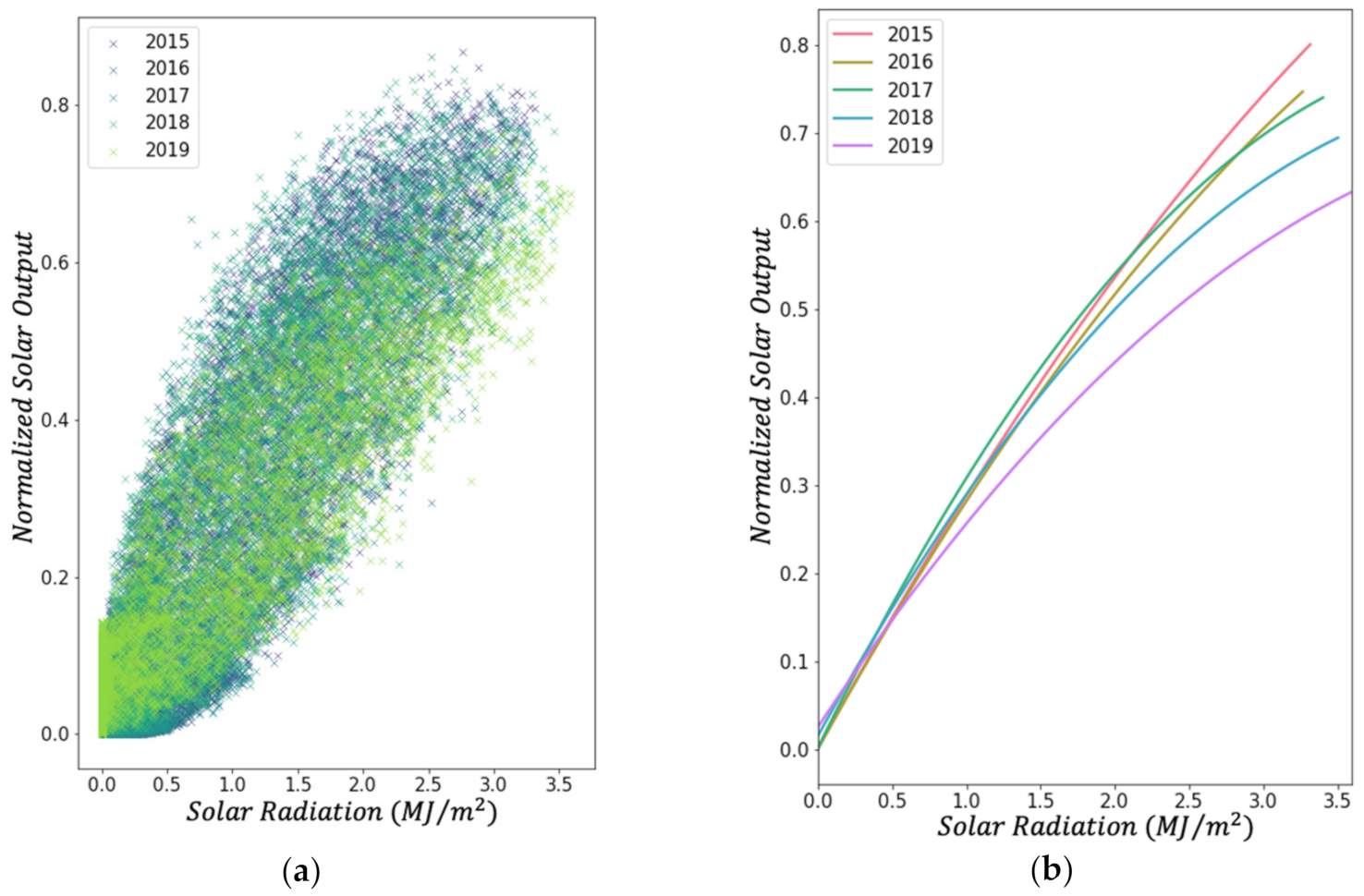
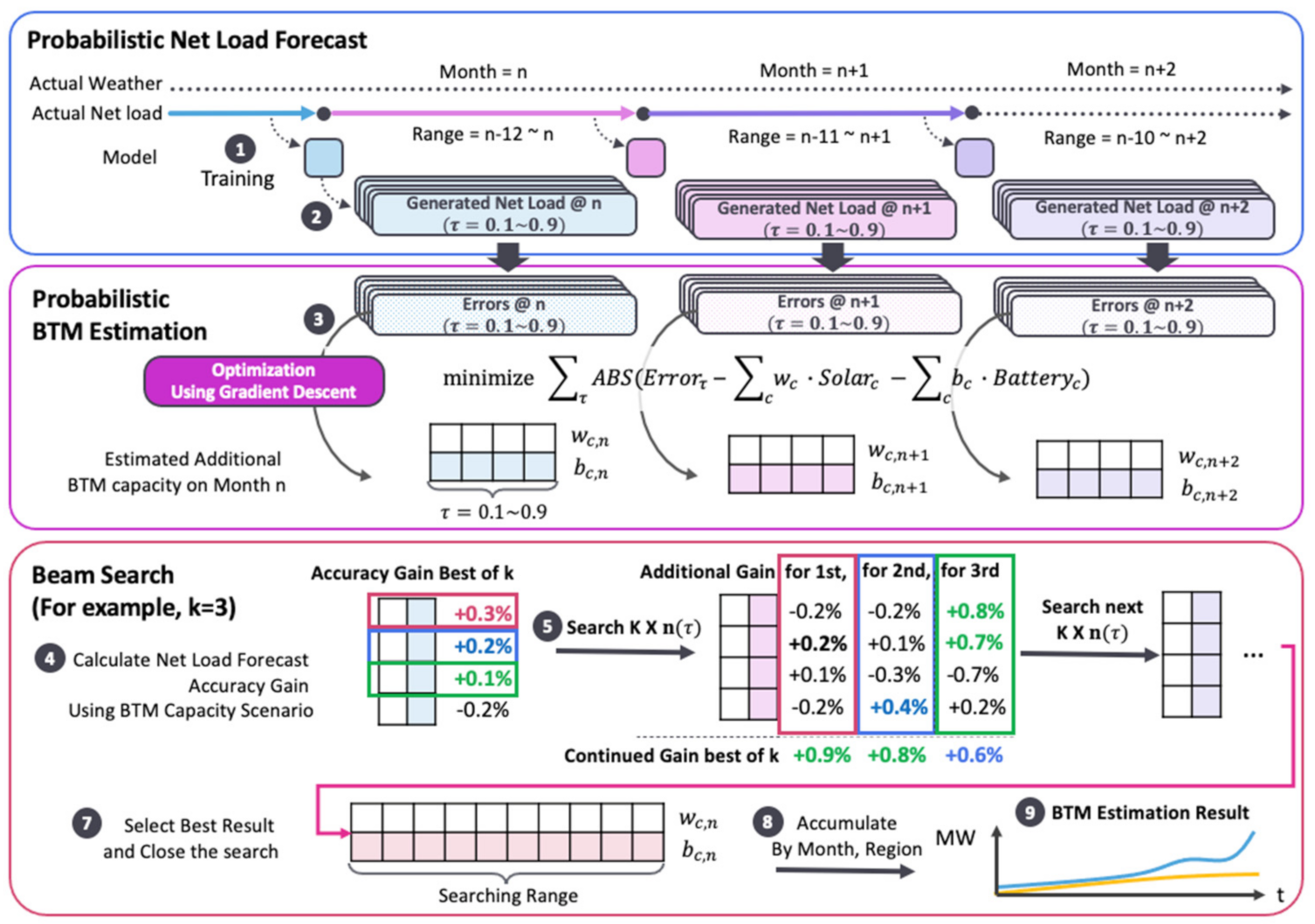


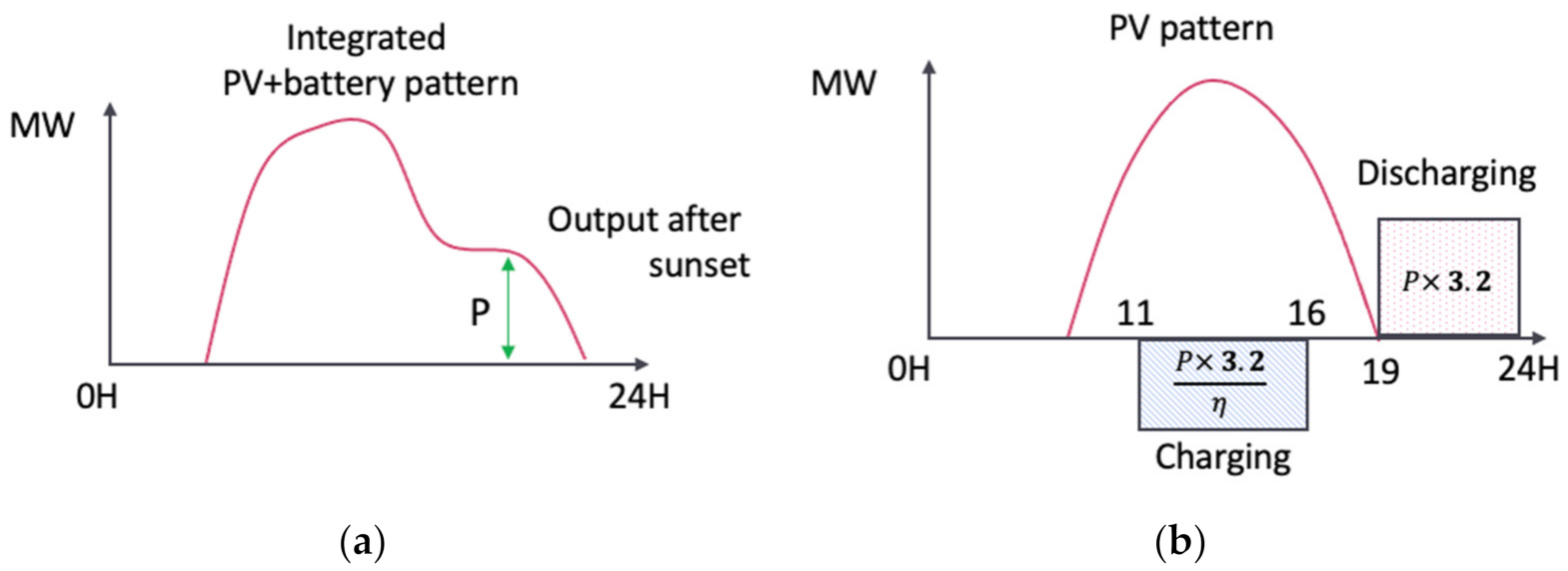
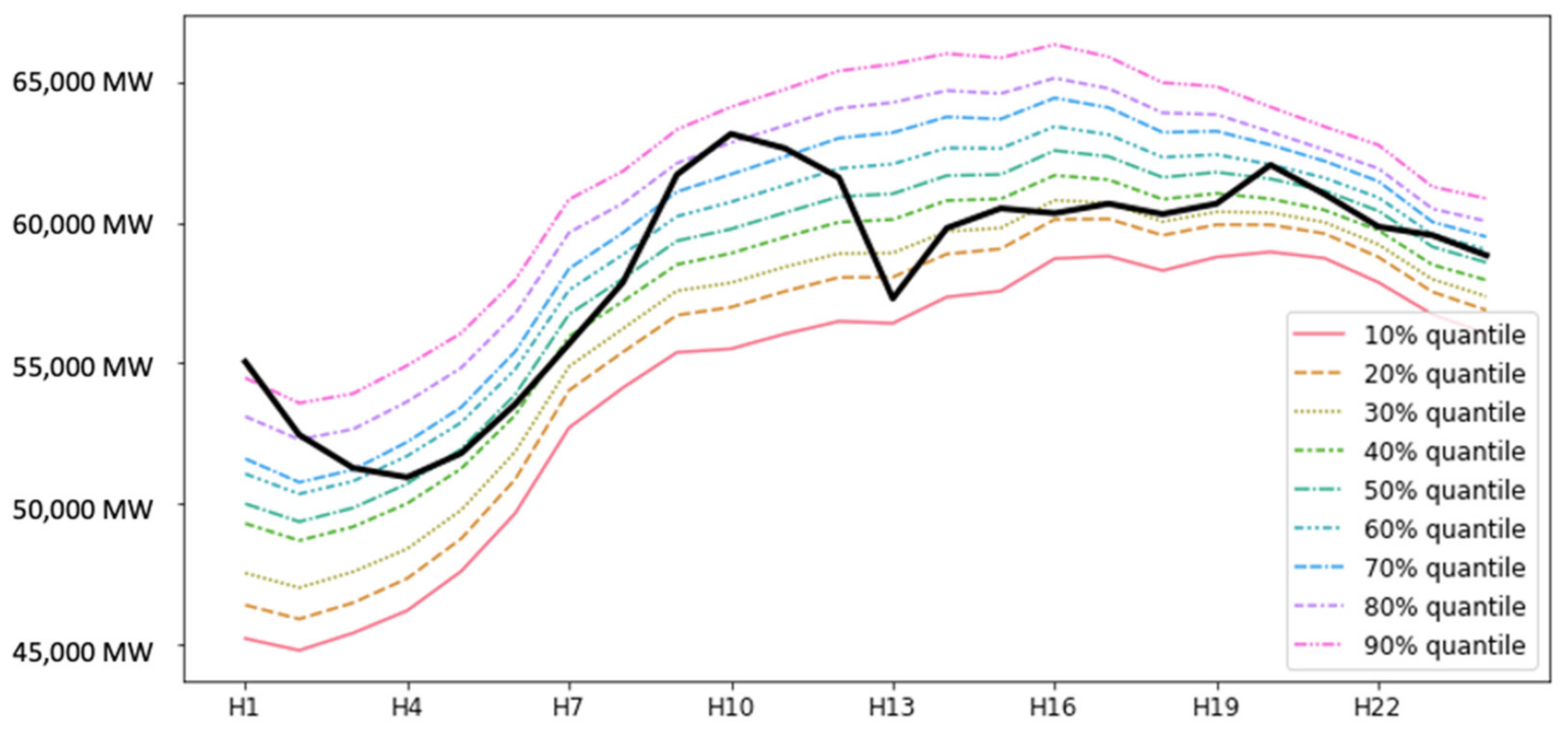




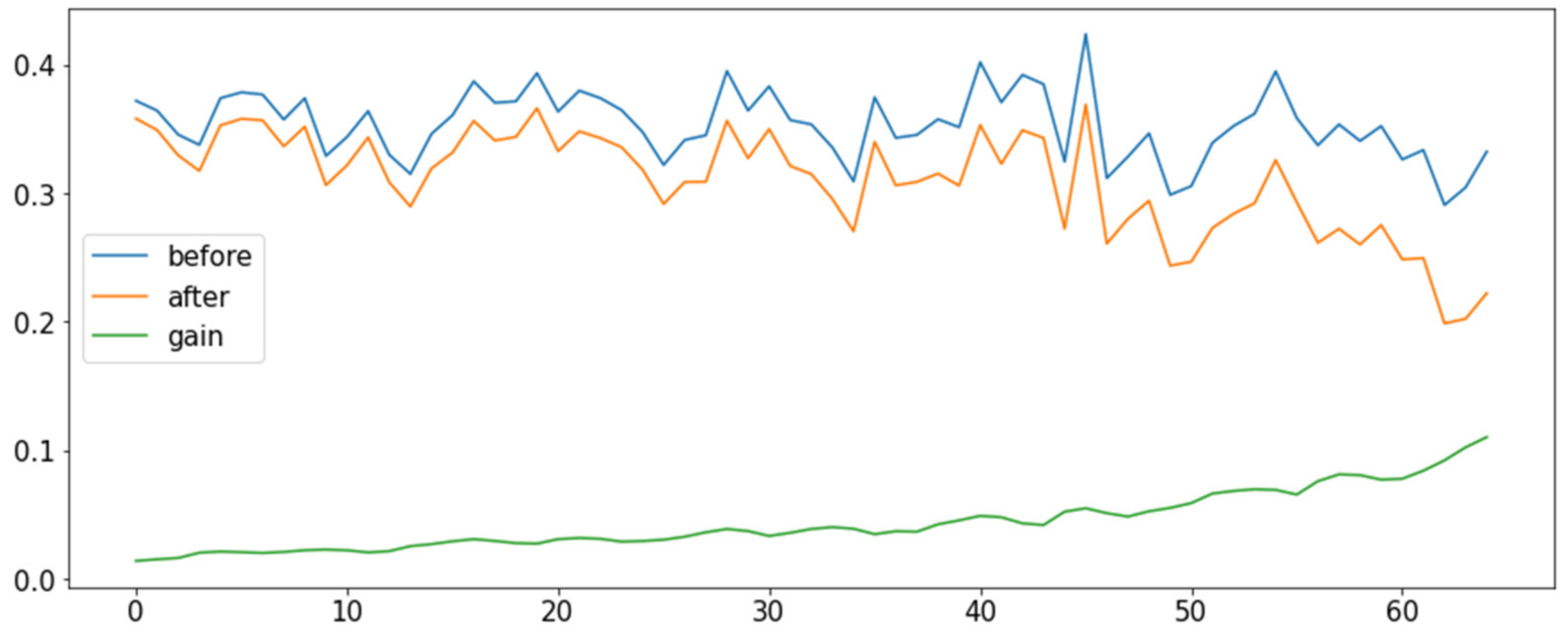
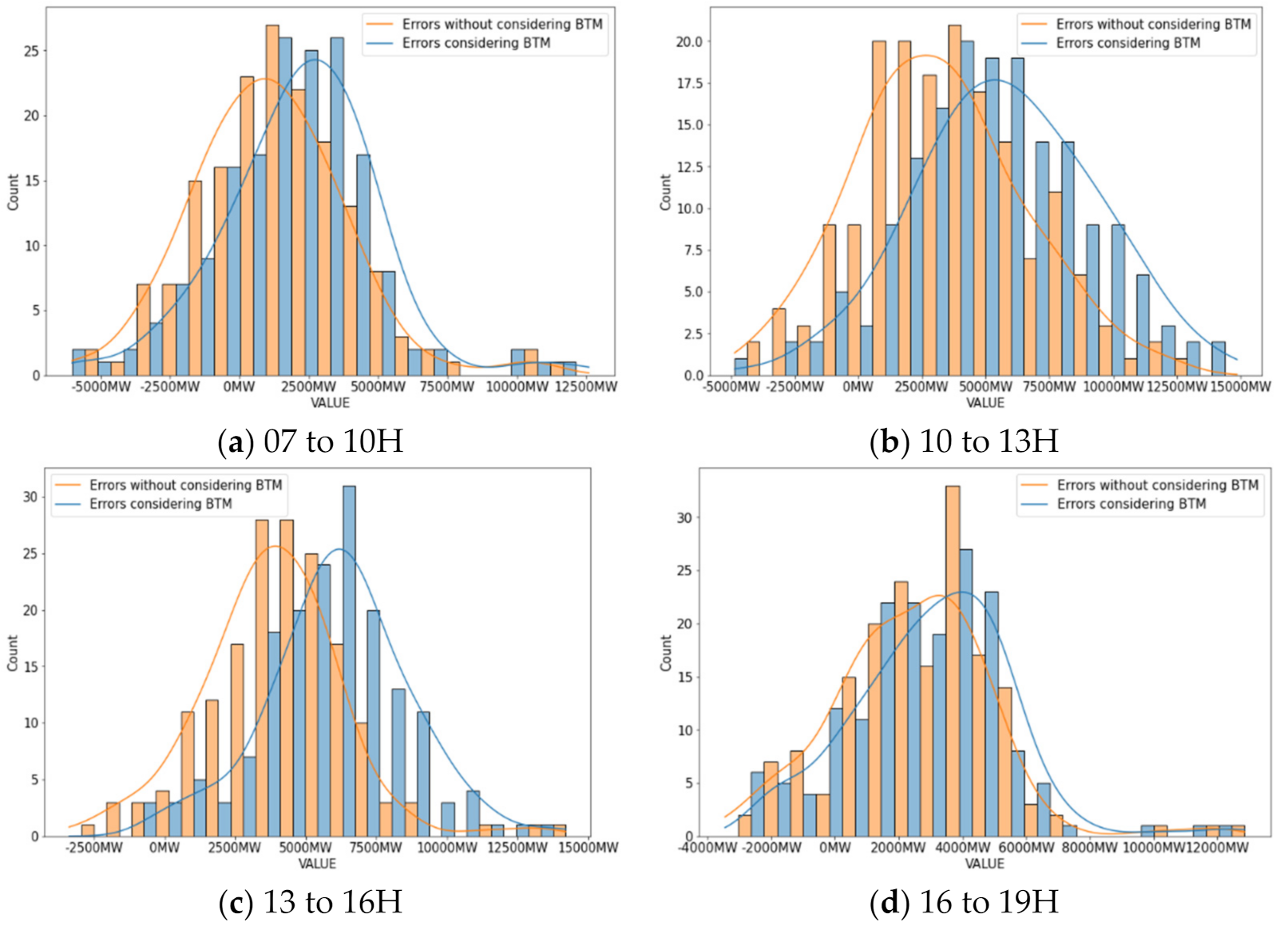
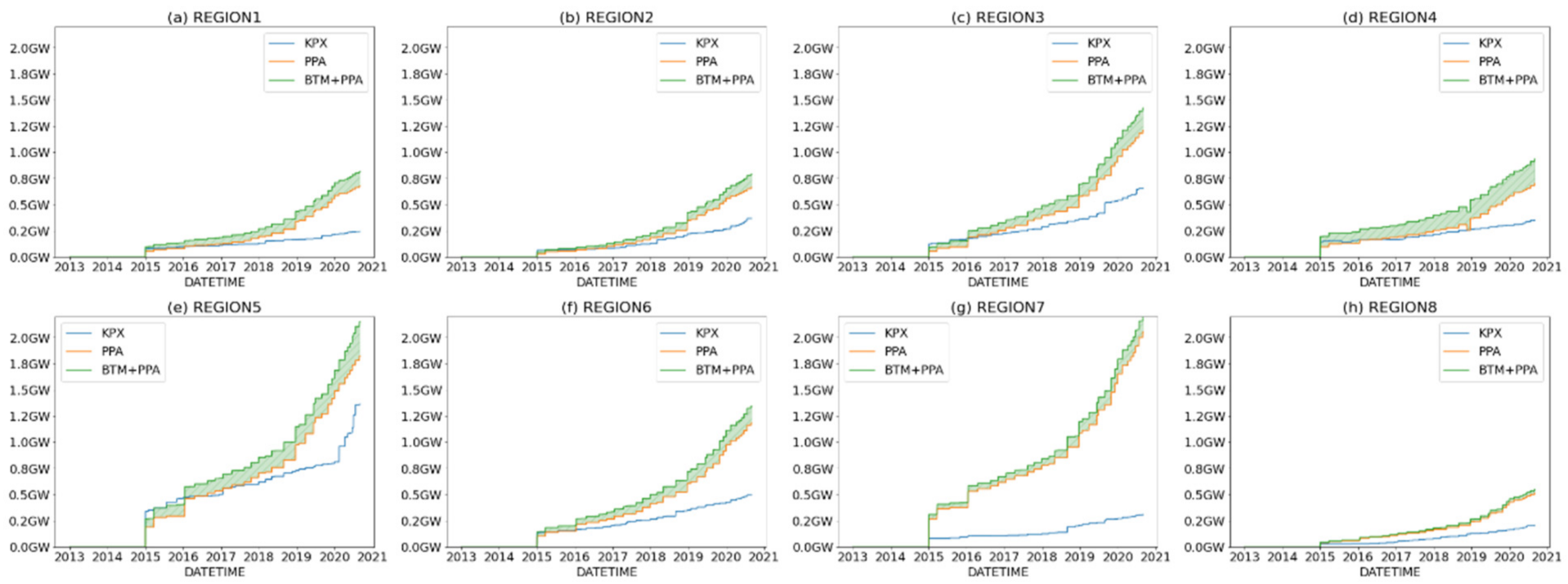
| Category | Result Validation | Forecasting Target | Characteristics | Techniques and Publications |
|---|---|---|---|---|
| (i) BTM estimation using alternative methods | Virtual Scenarios | Net load | Regional BTM PVs were modeled by adopting equivalent PV models. | MIC, GBM, QRNN [4] |
| Actual limited onsite PVs data | BTM PV | Used randomly chosen scenarios to overcome limited PV data. | Fuzzy [5] | |
| Net load | BTM patterns were used for post-correction of forecasted net load. | ANN [27] | ||
| Load forecast improvement | Net load | BTM PV estimation results validated by alternative method | GBM [6], ANN [2,3,7] | |
| (ii) BTM validation with true data points | Actual utility data | Residential load | BTM PV and BESS patterns were estimated simultaneously to improve housing load prediction. | Heuristic [13], Sensitivity Model [17], DNN [9] |
| BTM PV | BTM PV were estimated without considering net load forecasting accuracy or BTM BESS. | PCA [10], Fuzzy [11], HMM [12] | ||
| CBL | BTM PV estimation was used for improving the demand response analysis | SVR [15], K-means [8] | ||
| (iii) Various BTM Estimation methods | Actual utility data | BTM PV | BTM patterns were disaggregated from net load using the probabilistic modeling method. | MHMM [14], Random Forest, DNN, etc [23]. |
| BTM PV | Test dataset was generated using the simulator. | DNN [16] | ||
| Net load and BTM PV | A data-driven approach was used to estimate the behavior of BTM PVs. | Game Theory [18] | ||
| Economic evaluation | - | Estimating the configuration of BTM system using economic evaluation | Mixed-integer optimization [28], ROI, IRR [19] | |
| (iv) Load forecasting methods | Load forecast improvement | Net load | Various machine learning techniques were used for the net load forecasting | QRNN [20,21,22], LSTM [24] |
| Actual PV data | PV | Using weather conditions and locational data to forecast the PV outputs | Auto Encoder, LSTM [25], RNN [26] |
| Category | PV Capacity (MW) | Inverter Capacity (MW) | Battery Capacity (MWh) |
|---|---|---|---|
| Only PV | 1.0 | - | - |
| PV Plus BESS | 1.0 | 0.8 | 3.2 |
| Category | Contract Type | Meter Resolution | Capacity Monitoring |
|---|---|---|---|
| Front-the-Meter | Wholesale Market 1 | Hourly/Regional | Daily |
| Behind-the-Meter | PPA | Monthly/Regional | Irregularly |
| Private | Monthly/Regional | No |
| Name | Period | Feature Resolution | Provided Features |
|---|---|---|---|
| Load | 2013.01–2020.07 | Hourly | Observed Net Load (MW) |
| Demand Response Outputs | 2015.01–2020.07 | Hourly | Estimated Demand Response (MW) |
| FTM Outputs | 2015.01–2020.07 | Hourly | Integrated solar and BESS outputs by region |
| FTM Solar Capacity | 2015.01–2020.07 | Daily | |
| PPA Solar Capacity | 2015.01–2020.07 | Irregularly | |
| Observed Weather | 2013.01–2020.07 | Hourly | Temperature, Humidity, Cloud Amount, etc. by region |
| Forecasted Weather | 2013.01–2020.07 | 3 Hourly |
| Case without BTM | Case Considering BTM | |||
|---|---|---|---|---|
| Time Period | Test Statistics | p-Value | Test Statistics | p-Value |
| 7:00–10:00 | 0.9696 | 0.0010 | 0.9767 | 0.0062 |
| 10:00–13:00 | 0.9977 | 0.9970 | 0.9934 | 0.6418 |
| 13:00–16:00 | 0.9898 | 0.2725 | 0.9696 | 0.0010 |
| 16:00–19:00 | 0.9624 | 0.0002 | 0.9615 | 0.0001 |
| Average | 0.9799 | 0.3174 | 0.9753 | 0.1623 |
| Scenarios | Cases | M1 (Weak) | M2 (Linear) | M3 (LSTM) | |||
|---|---|---|---|---|---|---|---|
| MAPE (%) | StDev | MAPE (%) | StDev | MAPE (%) | StDev | ||
| Scenario A (Base) | Case I | 3.78 | 3.55 | 3.31 | 3.22 | 2.98 | 1.92 |
| Case II | 3.61 | 3.37 | 2.95 | 2.68 | 2.86 | 2.54 | |
| Case III | 3.55 | 3.30 | 3.04 | 2.97 | 2.56 | 2.47 | |
| Case IV | 3.56 | 3.34 | 2.96 | 2.70 | 2.43 | 2.25 | |
| Case V (Proposed) | - | - | 2.85 | 2.61 | 2.35 | 2.10 | |
| Scenario B (Without PPA) | Case I | 3.78 | 3.55 | 3.31 | 3.22 | 2.98 | 1.92 |
| Case II | 3.69 | 3.46 | 3.27 | 3.10 | 2.90 | 2.61 | |
| Case III | - | - | - | - | - | - | |
| Case IV | 3.60 | 3.48 | 3.15 | 2.65 | 2.85 | 2.44 | |
| Case V (Proposed) | - | - | 3.13 | 2.67 | 2.84 | 2.44 | |
| Scenario C (Without ReLU) | Case I | 3.78 | 3.55 | 3.31 | 3.22 | 2.98 | 1.92 |
| Case II | 3.73 | 3.46 | 3.05 | 2.94 | 2.94 | 2.63 | |
| Case III | 3.55 | 3.30 | 3.04 | 2.97 | 2.56 | 2.47 | |
| Case IV | 3.62 | 3.49 | 2.92 | 2.83 | 2.79 | 2.50 | |
| Case V(Proposed) | - | - | 2.88 | 2.80 | 2.58 | 2.26 | |
Publisher’s Note: MDPI stays neutral with regard to jurisdictional claims in published maps and institutional affiliations. |
© 2021 by the authors. Licensee MDPI, Basel, Switzerland. This article is an open access article distributed under the terms and conditions of the Creative Commons Attribution (CC BY) license (https://creativecommons.org/licenses/by/4.0/).
Share and Cite
Cha, J.-W.; Joo, S.-K. Probabilistic Short-Term Load Forecasting Incorporating Behind-the-Meter (BTM) Photovoltaic (PV) Generation and Battery Energy Storage Systems (BESSs). Energies 2021, 14, 7067. https://doi.org/10.3390/en14217067
Cha J-W, Joo S-K. Probabilistic Short-Term Load Forecasting Incorporating Behind-the-Meter (BTM) Photovoltaic (PV) Generation and Battery Energy Storage Systems (BESSs). Energies. 2021; 14(21):7067. https://doi.org/10.3390/en14217067
Chicago/Turabian StyleCha, Ji-Won, and Sung-Kwan Joo. 2021. "Probabilistic Short-Term Load Forecasting Incorporating Behind-the-Meter (BTM) Photovoltaic (PV) Generation and Battery Energy Storage Systems (BESSs)" Energies 14, no. 21: 7067. https://doi.org/10.3390/en14217067
APA StyleCha, J.-W., & Joo, S.-K. (2021). Probabilistic Short-Term Load Forecasting Incorporating Behind-the-Meter (BTM) Photovoltaic (PV) Generation and Battery Energy Storage Systems (BESSs). Energies, 14(21), 7067. https://doi.org/10.3390/en14217067






